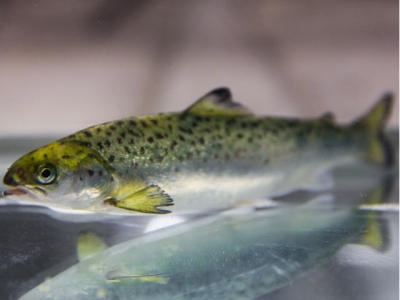How saline conditioning in post-smolts can help prevent winter ulcers

Smolt that have been kept in brackish water for two weeks in their hatcheries before being transferred to marine nets pens are less susceptible to skin ulcers caused by Tenacibaculum.
Tenacibaculum infections can cause lesions, known as winter ulcers, particularly during periods of low water temperatures. Photo: Nofima
So concludes new research organised by Cermaq R&D and the University of Bergen (UiB), which tested various smolt production strategies in relation to Tenacibaculum susceptibility.
Normally, post-smolt are transferred directly from fresh water to seawater shortly after smoltification. Other strategies include keeping the fish in fresh water for longer periods, or adding saltwater before transferring them to the sea. In connection with these trials, Nofima took samples of smolt before and after infection. This was done to investigate what happens in the skin when fish are infected.
The trials were carried out at the Industrial and Aquatic Laboratory (ILAB) in Bergen. After the fish were smoltified, post-smolt weighing 70 grams, 100 grams and 150 grams - in both fresh water and in brackish water (26 parts per thousand of salt) - were transferred to seawater and infected with the Tenacibaculum bacterium.
The team, which was led by UiB researcher Marte Fredriksen, used various histological tools to investigate where in the tissue the bacterium was located. The scientists also wanted to find out how the infection starts and what might affect it.

The team was led by University of Bergen researcher Marte Fredriksen. Photo: Reidun Lilleholt Kraugerud, Nofima
More tissue damage in freshwater fish
The study showed that the skin of salmon farmed in freshwater developed differently compared to the fish reared in brackish water. The surface of the skin of the freshwater salmon was also weaker than the skin of the brackish water salmon when transferred to seawater, explains Christian Karlsen, a fish health scientist at Nofima, who was Fredriksen’s supervisor:
“The most obvious effect was more damage to the epidermis of the freshwater fish, which worsened when the fish became infected. By putting this in context with the trial’s mortality rates, we believe that the transition to full-strength seawater is a greater strain on freshwater fish than on brackish water fish.
“This suggests that the fish can be acclimatised to seawater by keeping them in brackish water before transferring to seawater, therefore reducing the risk of tenacibaculosis.”
Structural skin differences
Studies of the smolts’ gene expression involving the different water qualities showed that the skin seems to prioritise immune defence responses at the expense of cell and tissue maintenance and development.
“The low-salinity fish are most likely better at mobilising their immune systems when they come into contact with the bacteria. The freshwater skin is slightly in shock and can’t gather itself to respond well enough in order to cope with the bacteria,” believes Karlsen.
Can the industry adapt production?
Cermaq R&D is the project’s work package manager and industry partner, and Cermaq’s Sverre Bang Småge will put the knowledge about water quality and ulceration into production.
“This project adds further strength to the hypothesis that prolonged time in purified seawater before transferral provides a number of benefits, both during the land phase and also later on in relation to the performance, health and welfare of the fish,” says Småge.
“One of the most important things in order for the fish to avoid infection is that the skin is intact, and we can influence that,” says Karlsen.
Related news
 Fake plants have real benefits for farmed tilapia - Part 1
Fake plants have real benefits for farmed tilapia - Part 1 The introduction of artificial water plants into tilapia aquaculture can lead to significant improvements in fish welfare at minimal expense to the farmer.
 Fake plants have real benefits for farmed tilapia - Part 2
Fake plants have real benefits for farmed tilapia - Part 2 In conclusion, a poor environment in fish farming has deficiencies that can be improved by including proposed enrichments
 How to improve broodstock selection
How to improve broodstock selection A device that can automatically choose which farmed fish should be retained for breeding purposes is currently under development.